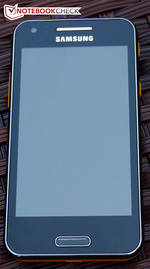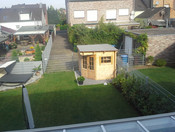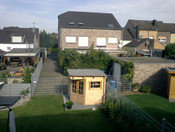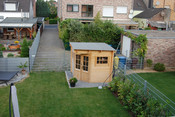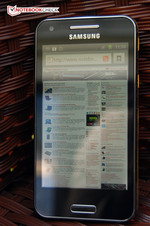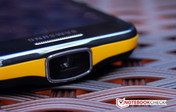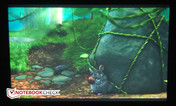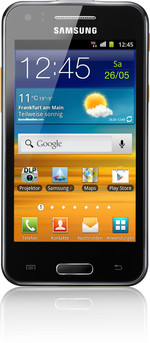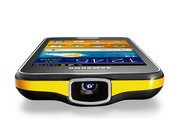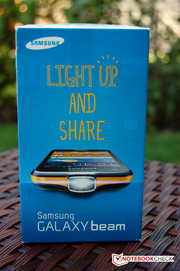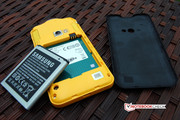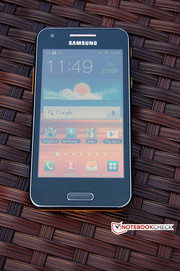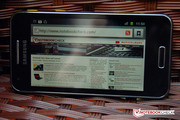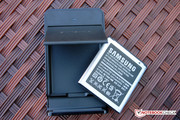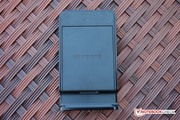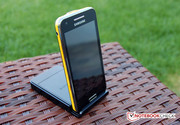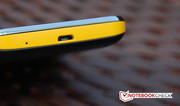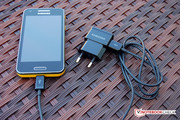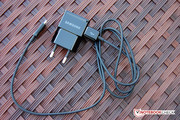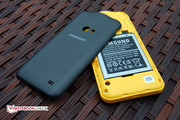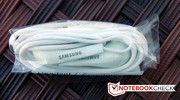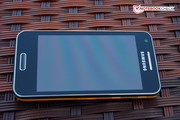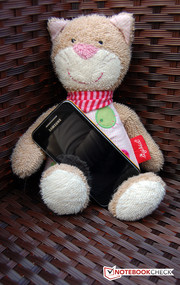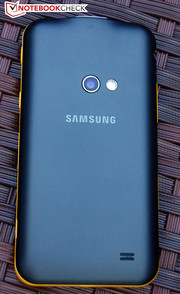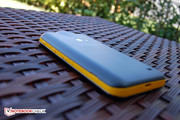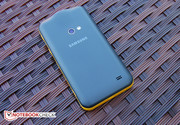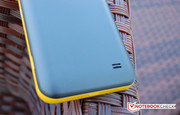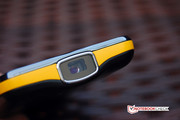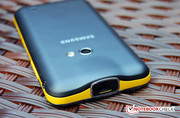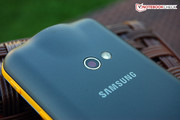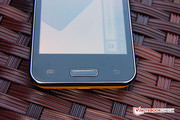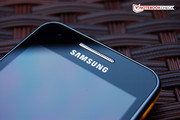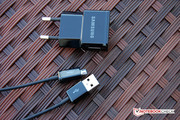Review Samsung Galaxy Beam (GT-I8530) Smartphone
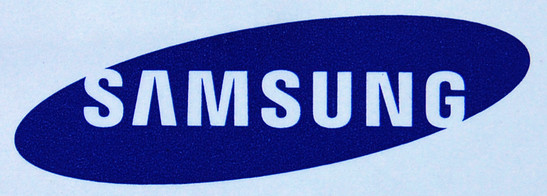
Samsung is a famous manufacturer of smartphones. The Korean manufacturer offers models ranging from high-end devices to cheap, entry-level phones. A wide number of operating systems are used to run these phones. The majority of the Samsung smartphones run on Google Android. The cheaper section has phones which run on Samsung's own Bada OS. On top of this, there are also devices which use the Windows Phone OS.
Of course, the Korean manufacturer has also covered special areas. For example, the Galaxy Xcover is an outdoors model and is quite new. In this review, we will test another niche model, the Samsung Galaxy beam. This test model is a middle-class smartphone and is equipped with an LED projector which is a rarity. However, Samsung has already launched a phone with a projector in 2010. Samsung promises a projection area of up to 50 inches (around 127 cm), which measures up to the size of large flat screen TVs. We are excited to see what this mini projector is capable of.
The rest of the specifications are not awe-inspiring: A 4 inch display, Android 2.3, 1 GHz dual-core CPU and 8 GB internal memory. All this is available for 539 Euros (~$700) – which is the recommended price and seems fair.
Case
Two things about the Samsung Galaxy beam catch your eye: the yellow border and the thicker upper edge. That is where the lens of the LED projector is installed. The Beam measures 12.6 mm at its thickest point which makes it a little chubby. The projector technology also adversely affects the weight. It measures a rather heavy 146 grams. Thankfully, the phone does not feel heavy in the jacket or pant pocket. The materials used for this phone are what would be expected for a middle-class device. The smartphone is made mainly of synthetic material. Only the capacitive touchscreen is protected by a glass panel. The back has a removable battery cover and is also made of synthetic material. However, this material is roughened so that it lies comfortably in the hand and does not slip easily. The user will need sharp fingernails to open the cover as there is no opening mechanism. It has to be "forcibly" removed. As the cover is quite flexible, the user will not have to worry about damaging it. The Samsung Galaxy beam beams in yellow under the cover. Inside, a large battery dominates the space and the camera and projector are not to be seen.
Under the screen, the phone has a so-called home button. It is quite long and to the left and right of it, there are sensor keys. These turn on once the screen is touched. The left button is the menu key and the right one is the back key.
Overall, the workmanship of the Samsung Galaxy beam has no flaws. Our impression of the materials used is also good.
Connectivity
One look at the connectivity of the Galaxy beam reveals that Samsung did not intend to make this a cutting-edge or powerful smartphone. This is an averagely-equipped model which is supposed to offer an interesting extra in the form of a projector, and thus make the smartphone worth the investment. A dual-core processor, from the relatively unknown manufacturer, ST-Ericsson, is the beating heart of our test model. The NovaThor U8500 is a SoC with integrated 3D graphics (ARM Mali 400). The clock frequency of the CPU is 1 GHz. The RAM is similarly meager at 768 MB. The internal memory amounts to 8 GB. That may not be much, but thanks to the microSD slot, the user can increase the memory by up to 32 GB at a nominal price.
The rest of the hardware can be quickly listed. The SIM card slot accepts SIM cards of normal size and is protected by a filigree flap (like the microSD slot). In addition, there is a combined USB charging port, two camera lenses, a small speaker on the back and a 3.5 mm headphone jack. Finally, we have the LED projector on the top of the device.
Software
Our test model runs on Android 2.3, which is known as Gingerbread. The version number 2.3.6 is the penultimate revision for Android Gingerbread. However, it's nearly been a year since it was launched. It is obligatory for Android 2.x Smartphones to have at least 3 keys with certain functions. The Samsung Galaxy beam has one physical key and two sensor keys (menu, home and return). All keys can be found at the lower screen edge. For smartphones, we always judge the positioning of ports from the vertical position, instead of horizontal, which is used for tablets, as they are usually held in that position.
Samsung has "saddled" its TouchWiz UI onto the Google OS. This is also an older release version 3.0. However, the user will not have to give up on much. TouchWiz 4.0 does not offer a lot more. We have not yet received any information about a possible OS update to a newer version of Android.
Communication & GPS
As expected of a middle-class smartphone, the Samsung Galaxy beam offers fast WLAN (802.11b/g/n) and has a 3G module which is HSPA+-ready. The phone offers transfer speeds of up to 14.4 MB/s downstream. Uploads can reach a maximum of 5.76 MB/s. The Beam is a quad-band model which works on the 850, 900, 1900 and 2100 MHz frequencies. Bluetooth is also provided. Versions 3.0 has better power-saving than its predecessors. Samsung also supports the Audio Streaming profile which allows wireless transmission of music to a car radio or another device. The GPS test application assures us that the installed A-GPS receiver works flawlessly. It takes a few seconds for the receiver to determine the location after it has been switched on. The reception remains stable even in narrow urban canyons.
Telephone functions
The telephone application is securely placed in the central home screen. It offers all the important features such as call lists, direct contact access and a favorites list. The menu key can open up many more context-related functions and settings. This allows the user to connect contacts to a Google account or take a look at the call details. Call settings such as call tone, number forwarding, etc. can be accessed via the system-wide settings menu. The proximity sensor, which switches the screen off as soon as the phone is moved to the ear, can be turned off. The dialing of a number directly from a website works, but with restrictions. If special keys or a space is in the number, the Samsung Galaxy Beam only dials the adjoining part of the number.
Cameras & Multimedia
Nowadays, even the middle-class of smartphones has accepted two cameras as standard. Thus, the Samsung Galaxy Beam is no exception to the rule. The front has a 1.3 MP sensor and the back has a 5 MP camera with LED flash. The camera application is easy to use and the user can only switch between the two cameras in photo mode. Movies can only be recorded by the rear camera. The highest resolution is 1280x720 pixels. The quality of the videos is decent, but the camera does not adjust well to brightness changes.
The quality of pictures taken with the front camera is bad. The photos lack clarity and are tinted blue. The rear camera captures much clearer pictures. Unfortunately, the pictures have a foggy quality. The colors are fine.
Accessories
Sensible accessories are provided for very few middle-class smartphones. The Samsung Galaxy Beam holds a nice surprise for us. The delivery includes the usual manuals and warranty cards. It also offers an in-ear stereo headset, extra ear buds and a Smartphone holder which is also the charging station for the secondary battery, which is also provided free-of-cost by Samsung – nice.
Warranty
There is little to mention here. The manufacturer warranty lasts 24 months. Options and extensions are not offered by Samsung.
Games
The GPU named ARM Mali-400 is part of the NovaThor U8500 SoC (System-on-a-Chip). Although the graphics chip of the Samsung Galaxy Beam only has a single core, the performance is sufficient for almost all games. We tested the 3D performance by running Need for Speed Hot Pursuit and Raging Thunder 2, as well as ShadowGun. ShadowGun suffered from a few instances of stuttering. However this did not spoil the gaming experience. We expect future developments in game graphics to quickly push the Samsung Galaxy beam to its limits. However, right now, even racing games like the two mentioned above, run beautifully on the smartphone.
The position sensor of the smartphone is quite sensitive to changes. Although it takes a while to get used to, this feature gives the user precise control in games. The touchscreen also makes playing games fun.
Input Devices and Interface
As the Samsung Galaxy beam runs on Android 2.3, it needs a physical key. The need for such physical buttons was eliminated by Google Android 4.0 aka Ice Cream Sandwich. Modern smartphones which use Android 4.0, only have the power button and volume rocker as physical keys.
The home, menu and back keys will not cause any problems on a smartphone which is primarily used in portrait mode. In fact, they permit the user to quickly access important functions. There is very little to criticize about the interface of the Samsung Galaxy beam. Android Gingerbread is quite refined despite being outdated. We would have liked to have a native screenshot function and a fresher look. Slight stutters while scrolling through the contacts or long webpages are caused by the relatively slower processor and outdated OS. Overall, the device runs quite fluidly, although most Apps require some time to start.
The touchscreen is also satisfactory. Sometimes, the screen may not react when first touched. Turning the screen causes the phone to pause slightly. The phone cannot be used upside down, but turning it to either side works.
Display
The display is 4 inches in size and fits nicely in this segment. That also applies to the resolution of 800x480 pixels. Of course, there are manufacturers like LG, who would install an HD display in this price range. Of course, you would not have a projector on board then. As such, we believe the resolution to be appropriate.
Samsung has not given any details about the panel technology used for the Galaxy Beam. We believe it to be IPS technology due to the great viewing angles. The naked test results of the display are meager. The maximum and average brightness of 116 cd/m2 and 108.1 cd/m2 is not enough for use in normal sunlight. This means that in bright rooms or outdoors in the sunlight, it is quite hard to read anything off of the screen. Thankfully, the panel has a high contrast of 760:1, which comes from the great black value of 0.15 cd/m2. The illumination is also meager at 84%. When held in landscape mode, the brightness in the bottom right corner falls quite a bit to 97 cd/m2.
| |||||||||||||||||||||||||
Brightness Distribution: 84 %
Center on Battery: 114 cd/m²
Contrast: 760:1 (Black: 0.15 cd/m²)
Despite the low brightness, the picture quality of the Samsung Galaxy beam is respectable. Pictures and videos come to life thanks to the satisfying black tones and high contrast. True-to-life, strong colors are displayed on the screen. Sadly, due to the low brightness the Smartphone cannot make the most of these amazing qualities. As soon as the sun starts shining strongly, the joy of looking at the screen fades.
Due to the reflective display and the lacking brightness, outdoors use is not a pleasure. As mentioned before, as soon as the sun starts shining, the display content is hard to recognize and the viewing angle becomes small. Often, the user has to use their hand to shadow the screen to see anything at all. This poor brightness is a disappointment for a phone which is intended to be used on the go for surfing on the Internet or capturing photos.
The viewing angle stability is much better. Both horizontally and vertically, the colors remain stable even up to very wide angles. The colors do not invert. The brightness and contrast do drop at wider angles, which is quite bad as the brightness is already limited.
LED Projector
The Samsung Galaxy Beam is named after the Pico projector built into its head. The projector uses DLP technology and LED lighting. The lens measures 16 mm x 10 mm (including the border). This makes our test model slightly heavier than most Android devices, but due to the rarity of a feature like the projector, we will look the other way.
Samsung has announced a luminous flux of 15 ANSI lumens. This may sound to be little to anyone who is experienced with projectors. Most normal projectors require at least 2000 ANSI lumens for sufficient brightness. However, that allows the user to project over an area of 3 square meters and even in daylight. This is not the purpose of the Galaxy Beam. The projector can create a projection of up to 50 inches (diagonally). The room should be darkened for this. The result is truly worth taking a look at. Of course, the buyer should not expect a wonder given the resolution of 640x360 pixels. Still, the projector is well-suited for the projection of a YouTube video with friends and will definitely cause a few jaws to drop. The overhead function is quite nice. The projector emits the picture taken by the camera on the wall in real time. The beamer can also be used as a flashlight which can be quite useful.
Performance
For a middle-class smartphone, the Samsung Galaxy Beam is equipped appropriately for its time with a dual-core 1 GHz CPU. The RAM should have been a little more than the offered 768 MB. To judge the performance of the Smartphone, we did a comparison with recently tested tablets, as we have not tested any similar smartphones recently. The comparison is pretty fair as tablets are based on basically the same technology.
The benchmarks show that the Samsung Galaxy Beam cannot compete with the current high-end platforms like the Nvidia Tegra 3 or the Samsung Exynos 4412 which are both quad-core SoCs. Tablets, like the Asus Transformer Pad Infinity TF700T or the Samsung Galaxy Note 10.1 thoroughly beat the Galaxy beam in terms of performance. However, that was to be expected. Middle-class tablets, like the Motorola Xoom 2 and the Samsung Galaxy Tab 2 10.1 are much closer to the Samsung Galaxy beam. Sadly, due to the limited RAM and single-core GPU, the performance is limited and the smartphone is beaten in almost all categories.
In terms of performance, the Samsung Galaxy beam offers sufficient performance for a middle-class device. Working with the phone is a fluid experience with the exception of one or two instances. Of course, the device does not have any reserves for future software.
| AnTuTu v2 - Total Score (sort by value) | |
| Samsung Galaxy beam | |
| Asus Asus Transformer Pad Infinity TF700T | |
| Google Nexus 7 | |
| Samsung Galaxy Tab 2 10.1 | |
| Samsung Galaxy Note 10.1 | |
| Samsung Galaxy S3 | |
| HTC One S | |
| Vellamo Mobile Web Benchmark 1.0.6 - Overall Score (sort by value) | |
| Samsung Galaxy beam | |
| Asus Asus Transformer Pad Infinity TF700T | |
| Google Nexus 7 | |
| Samsung Galaxy Tab 2 10.1 | |
| Samsung Galaxy Note 10.1 | |
| Samsung Galaxy S3 | |
| HTC One S | |
* ... smaller is better
Emissions
Noise Emissions
Usually, Smartphones and tablets are silent in this section, and they only make noises when the user wants them to. The Samsung Galaxy Beam is somewhat of an exception. This is due to the power adapter which emits an annoying, high-frequency buzzing sound when it is plugged into the socket, but not to the phone. Of course, most users may not find this to be a problem. However, the author leaves power adapters plugged into sockets for weeks. As such, this annoying issue caused him to search for the source of the noise for an entire day, and that is why he found this issue worth mentioning. With the exception of the power adapter, the Samsung Galaxy Beam remains silent and that is excellent.
Temperatures
The Samsung Galaxy Beam is no hot-head, as is shown by our temperature measurements. In everyday use, the maximum temperature reached by the device is 33.4 degrees Celsius, about as warm as a hand. There are also smartphones with stronger CPUs which remain cooler like the HTC One S. In the stability test, the CPU and GPU are stressed to the maximum and the temperatures at our 9 measurement points rise significantly. However, they remain below 43 degrees Celsius which means there is nothing to worry about.
(±) The maximum temperature on the upper side is 41.2 °C / 106 F, compared to the average of 35.2 °C / 95 F, ranging from 21.9 to 247 °C for the class Smartphone.
(±) The bottom heats up to a maximum of 42.7 °C / 109 F, compared to the average of 34 °C / 93 F
(+) In idle usage, the average temperature for the upper side is 31.7 °C / 89 F, compared to the device average of 32.9 °C / 91 F.
Speakers
The speakers installed in the back of the Samsung Galaxy beam will probably be mainly used as a loudspeaker for calls or for sound output of a YouTube video. The user should not expect more from the mini box. The speaker does its job passably. It is quite loud and the highs are too dominant. Very high notes can be uncomfortable to hear. The small speaker has no bass to offer. Its volume is sufficient for a loudspeaker and for short calls, the quality is sufficient. The provided stereo headset should be used for longer calls or enjoying music. It performs its duty quite well.
Battery Life
Power Consumption
Samsung has provided our test model with a 7.6 Wh battery and has also packed in a second, identical battery with a charging station in the delivery package. The double batteries come in handy when using the projector. The Lithium-Ion battery has a capacity of 2000 mAh which is decent for a Smartphone.
The power consumption of the Samsung Galaxy beam is very conservative while the projector is off. While idle, the power consumption ranges between 1.5 and 2.2 W. At full load, the power consumption without the projector rises up to 2.8 W. When the projector is turned on, the power usage can reach up to 3.9 W.
| Off / Standby | |
| Idle | |
| Load |
|
Key:
min: | |
Battery Life
The two identical batteries give the Galaxy beam enough reserves. Our tests were only run on a single battery. The second battery will double the run times as it has identical specifications.
The maximum run time is measured with lowest brightness and all communication modules turned off. Only the WLAN is on as we need to load a special text script. The smartphone's own power-saving mode is also turned on. 18 hours and 13 minutes is a decent run time for the Samsung Galaxy beam. The same is true for the WLAN surf test as well, but with one difference. We normally test at a brightness of 150 cd/m2, but as the Samsung Galaxy beam cannot reach this level, we tested the smartphone with full brightness. This gives the test model a clear advantage over other models which have higher brightness. Still, the run time of 10 hours and 25 minutes is quite good. Even at load (Stability test), the smartphone can run for four and a half hours.
The run time with the projector on is also a topic of interest. The test model lasted slightly more than 3 hours in this test. That is a respectable run time in our opinion. After all, the second battery is always available.
Reliable estimations of the possible talk times in 2G and 3G mode are always hard to make as the results vary depending on the reception, surroundings and base station which the smartphone is currently using. Samsung proclaims up to 15 hours talk time in the GSM network and up to 9 hours in UMTS use. We tested the phone in both networks for one hour with a full battery. The remaining battery level in 2G was 94% and 91% for 3G. This means that the numbers provided by Samsung are quite accurate.
The battery life of the Samsung Galaxy beam is very good. Paired with the second battery, the device can run for multiple days.
Verdict
Without the projector, the Samsung Galaxy Beam would be just another middle-class smartphone. However, this Pico projector turns the Samsung beam into a unique piece in the smartphone scene.
The workmanship looks and feels fine, but the buyer should not expect anything other than synthetic material for this category. That also applies to the hardware. A dual-core CPU and 768 MB RAM may not be generous, but they suffice for the current tasks. The 800x480 pixels resolution leaves room for improvement, but fits well for the smartphone.
The operating system is the outdated Android 2.3 Gingerbread. If the user has used a phone with Android 4, then he/she will notice that Gingerbread is slightly outdated. However, this does not mean that the system is bad. The long development has culminated in a stable OS which can be intuitively used.
The main weakness of the Samsung Galaxy Beam would be the display. Although the colors, contrast and viewing angles are good, the brightness is far too low, and the phone cannot fully show off its strengths.
The projector of the Galaxy beam is a useful feature. The flashlight function will definitely come in handy from time to time and the phone is also good for video projections - at least, good enough to impress your friends.
Samsung has delivered a second, identical battery with a charging station. It is a generous decision which allows the smartphone to run for a long time. Although, even on one battery, the smartphone manages to last quite long.
With the exception of the display, few things about the Samsung Galaxy Beam bother us. The high-pitched buzzing of the power adapter annoyed the tester. However, this only occurs when the adapter is in the power socket and not connected to the phone.
At the end of the day, the Samsung Galaxy Beam is a good middle-class smartphone which offers a lot of functionality and projector. In our opinion, the recommended price of 539 Euro (~$700) is too high. To answer the question we posed at the start of this review: the Gingerbread may be older, but it is far from being decrepit.


